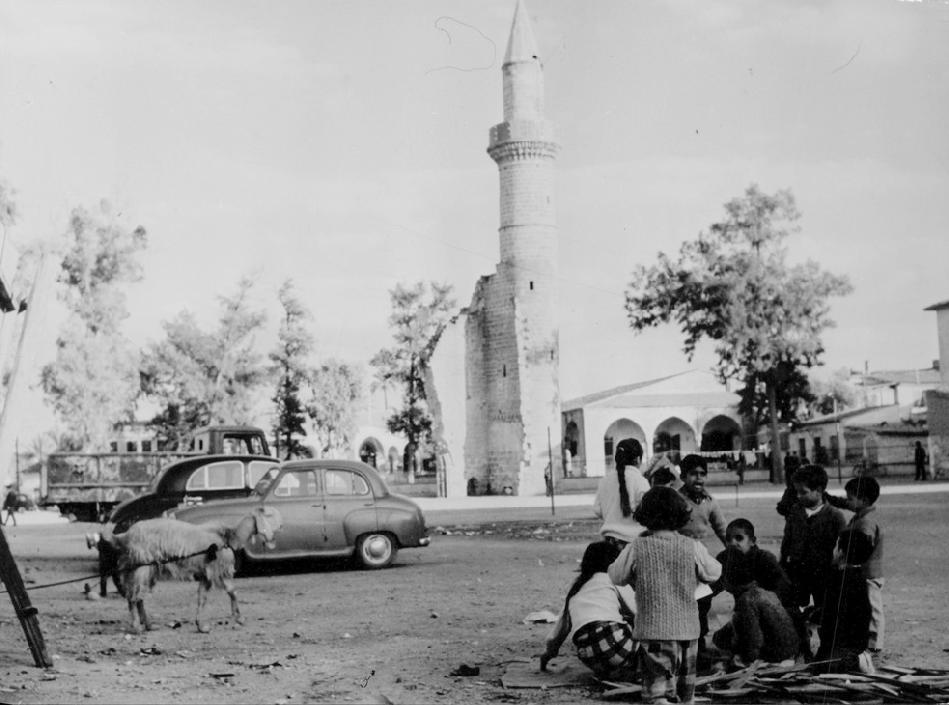
Cypriot History: Ottoman Era (1571-1878)

Figure 1.--Here Cypriot children gather on a side street, we think in the capital of Nicosea. The photograph was taken in 1964. Part of the island's turbulent history is the Ottoman invasion (1570). The island with its rugged interior including wine-growing regions evolved into a Greek south and Turkish north, with Nicosia also divided. There are many fascinating archaeological sites, There are ancient temples such as one to the cult of Aphrodite, palaces, tombs, mmosaic-adorned villas, churches, ans mosques. Here we see the ruins of an an Ottomam mosque.
|
|
The Ottomans a few decades after seizing the arab Middle East launched a naval offensive against Cyprus. Naval power was as the time shifting toward the Christain West. The Holy League decisively defeated the Ottoman Navy at Lepanto (1571). But before that the Ottomans as the Venitians expected, attacked Cyprus (1570). Cypus was located just south of Anatolia, the Turkish hearland of the Ottoman Empire. They took Nicosia and slaughtered the population of 20,000 people. They layed siege to Famagusta. Venetian commander Marc Antonio Bragadin holds out for a year. Starvation eventually forced them to surrender to Ottoman commander Lala Mustafa. He at first offered free passage, but is outraged when he sees what a pitifully small force has opposed him. He ordered Bragadin to be flayed alive and then drawn and quartered. The others are slaughtered. The Ottomons add Cyprus to their Empire. The Ottomans because Western reistance was centered on the Catholic powers and the papacy, suppressed the Roman Catholic Church and restored the more familar andsubmissive Orthodox hierarchy. Roman Catholics are expelled or forcibly converted to Islam. The Ottomans restore the Greek Orthodox faith on the island. The Archibishop as leader of the Greek Orthodox Church, becomes the representative of the Cypriot people to the Sultan. Under Ottoman rule a Turkish minority develops. The Ottomans settle some 20,000 Turks on the island, but in general take little interest in their new possession. Few Cypriots convert to Islam. The Cypriot peasantry had long suffered under a feudal tenancy system which denined them much of the fruit of their labors. The Ottomans ininiated a land ownership scheme. They at first reduced taxes, but over time tax rates rose. This was a often an arbitrary process imposed by Ottoman officials. The Orthodox archbishop was made responsible responsible for collecting the Ottoman taxes. Some 20,000 Turks were settled on Cyprus following its capture, the beginning of the modern Turkish minority on the island. Cyprus was, however, not high in the priorities of Otoman sultans. A factor here was that Ottoman seapower after the disatrous defeat at Lepanto was declining (1571). One historian describes Ottoman rule as a period of 'Indolence, corruption and sloth'. The Ottomans ruled Cyprus for 300 years and at a very critical pont of history. It meant at a time that Western Europe was undergoing a remarkable transition from fedudalism to modernity, Cyprus was cut off from these influences, but rather languished under the intelecually backward, but still powerful Ottoman Empire. The Ottomans brooked no dissent and any public expression was brutally repressed. The Greek Cypriots were even punished for dissent on the Greek mainland. The Ottomans after the Greeks launched their War of Independence on the Mainland (1821) hung the Archibishop of Cyprus, Kyprianos, three bishops and hundreds of Greek civic leaders as a reprisal punishment.
CIH

Navigate the Children in History Website:
[Return to the Main Cyprus history country page]
[Return to the Main European history country page]
[Return to the Main Cyprus page]
[Return to the Main Ottoman page]
[About Us]
[Introduction]
[Biographies]
[Chronology]
[Climatology]
[Clothing]
[Disease and Health]
[Economics]
[Freedom]
[Geography]
[History]
[Human Nature]
[Ideology]
[Law]
[Nationalism]
[Presidents]
[Religion]
[Royalty]
[Science]
[Social Class]
[Bibliographies]
[Contributions]
[FAQs]
[Glossaries]
[Images]
[Links]
[Registration]
[Tools]
[Children in History Home]
Navigate the Boys' Historical Clothing Web Site:
[Return to main country page]
[Australia]
[Canada]
[England]
[France]
[Germany]
[Ireland]
[Italy]
[New Zealand]
[Scotland]
[United States]
Crerated: 11:00 PM 11/6/2016
Last updated: 11:00 PM 11/6/2016



